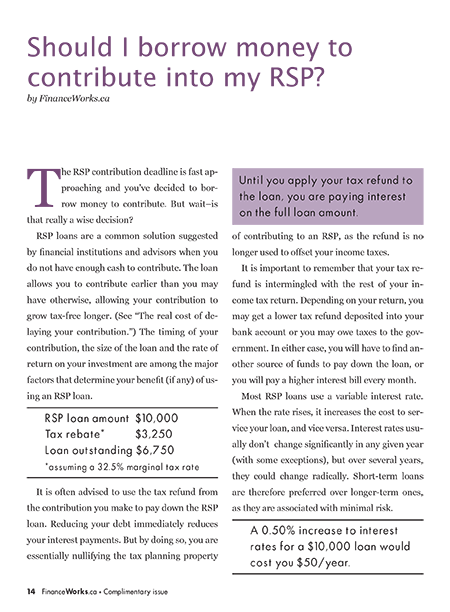RRSP contribution or mortgage repayment Fiscal Agents Money Management Newsletter
Post on: 16 Март, 2015 No Comment

RRSP contribution or mortgage repayment?
A Companion Advisor Article
Mackenzie Financial Corporation
Many clients face a dilemma during their peak earning years. They know they should maximize their RRSPs. but they are also highly motivated to repay their mortgage — the biggest debt of their lives.
We tell them not to wait until the house is totally paid off before starting their RRSPs! You will lose so many years of potential savings, that it will be virtually impossible to catch up. Let me prove this with the following example.
Bill Jones is 30 years old and in the 40% tax bracket. He has a $150,000 mortgage. which he’s repaying at $1,170 monthly, based on a 25-year amortization period and 8% interest. He is able to save $3,500 annually, and opts to put this entire sum into his mortgage. He plans to start contributing to his RRSP once his house is paid off.
Mary Smith starts off in the exact same position. She too is 30, and her $150,000 mortgage has the same terms and repayment schedule as Bill’s. But she opts to put her annual savings of $3,500 into her RRSP instead of prepaying her mortgage. In her 40% tax bracket, this RRSP contribution entitles her to a $1,400 tax refund, which she does put against her mortgage. Over the years, her RRSP return averages 12% annually.
Here’s how their decisions play out over time.
Bill will pay down his mortgage in 16 years. Because he got no deduction for RRSP contributions over that 16-year period, he will have paid $22,400 in taxes that Mary avoided. At age 46, he is finally ready to start his RRSP: he will replace his monthly $1,170 mortgage repayment with a monthly $1,170 RRSP contribution, which will maximize his annual contribution.
At this point in time, Mary is also 46. She owes almost $47,000 on her house and is four years away from discharging her mortgage. Her RRSP has grown to almost $170,000. She plans to continue her annual $3,500 RRSP contribution for the next four years, and continue applying her $1,400 tax refund against her mortgage. At that point, she too will replace her $1,170 monthly mortgage repayment with a monthly $1,170 RRSP contribution.

Now let’s see where they’re at when they turn 65. Both of them have paid-off homes of equivalent value. But Bill’s RRSP is worth about $765,000, while Mary has a plan worth almost $3.5 million. Mary’s 16-year jump-start has paid off with almost three million dollars more in her pocket.
Summary & Comments
For most people, Mary’s strategy — put your savings into RRSPs, then apply your tax refund to your mortgage — is the ideal answer to the mortgage or RRSP question. A well-diversified RRSP portfolio could provide earnings considerably higher than the advantages of pre-paying your mortgage and this assumption is the reason why there is such a huge difference between two ending RRSP values in this illustration. The assumed investment return of 12% is substantially higher than the mortgage rate of 8%. This may not actually be the case in a real life situation and tweaking the figures so that the investment return averages 6% rather than 12% leaves Mary with an RRSP value closer to $664,000 and Bill with an RRSP value of around $490,000 at age 65. Mary’s ending RRSP value is almost $3 million less in this case than with the 12% investment rate, which if nothing else shows the power of compounding when investment yields are high.
There are shades of grey in any scenario and it is best to work through your situation with prevailing rates and realistic investment returns. The final picture for Bill and Mary would also look different if they both accelerated their mortgage repayment by making one extra mortgage payment per year. This would take several years of payments off their mortgages and start the RRSP savings faster.
Use the Bill and Mary comparison as a jump start to review your own situation, play with some figures using Fiscal Agents’ calculators and see what you can actually accomplish by aggressive debt repayment and dedicated savings.














